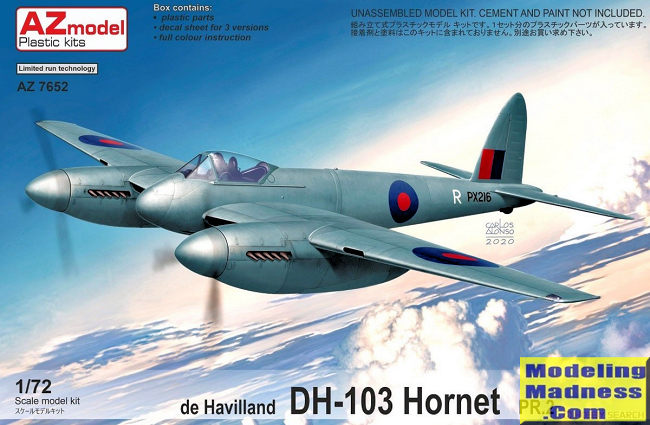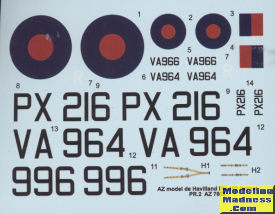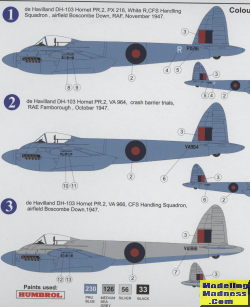
AZ Models 1/72 Hornet PR.2
| KIT #: | AZ 7652 |
| PRICE: | $30.00 or so |
| DECALS: | Three options |
| REVIEWER: | Scott Van Aken |
| NOTES: |

| HISTORY |
The de Havilland DH.103 Hornet, developed by de Havilland, was a fighter aircraft driven by two piston engines. It further exploited the wooden construction techniques that had been pioneered by the de Havilland Mosquito. Development of the Hornet had started during the Second World War as a private venture. The aircraft was to conduct long range fighter operations in the Pacific Theatre against the Empire of Japan but the war ended before the Hornet reached operational squadron status.
The Hornet entered service with RAF Fighter Command where it equipped several day fighter units and was commonly stationed in the British mainland. It saw combat in the Far East, being used as a strike fighter as part of the British military action taken during the Malayan Emergency.
The Hornet PR.2 was intended to operate as a long-range photo-reconnaissance aircraft. The Hispano cannon were removed and cameras were mounted in the rear fuselage. Total internal fuel capacity was increased to 528 gal (2,400 l). PX216, PX220 and PX249, were converted from standard Hornet F.1 aircraft, later followed by five more.
| THE KIT |
 AZ
Models' Hornet family was highly anticipated by those who found fault with the
MPM/Special Hobby versions. The kit is nicely molded as you'd expect from a
modern short run kit. The cockpit is well done and you are provided a decal for
the seat harness, something I like seeing in kits of this scale. There is no
decal for the main instrument panel, but there is detail there. For the side
console, a paper panel is provided in the instructions. Before trapping the
cockpit sections in the fuselage, a small rear bulkhead is provided for near the
tail gear.
AZ
Models' Hornet family was highly anticipated by those who found fault with the
MPM/Special Hobby versions. The kit is nicely molded as you'd expect from a
modern short run kit. The cockpit is well done and you are provided a decal for
the seat harness, something I like seeing in kits of this scale. There is no
decal for the main instrument panel, but there is detail there. For the side
console, a paper panel is provided in the instructions. Before trapping the
cockpit sections in the fuselage, a small rear bulkhead is provided for near the
tail gear.
When assembling the wings, one must first install small main gear well slivers into the lower wings to fill the small gap that would otherwise be in between the wing halves. There are also radiator blocks to place in the lower wings along with landing lights. The engine nacelles have the exhaust inserted from the inside and have fore and aft gear well blanking plates. These all come together along with the fuselage. There are tabs on the fuselage that fit into wing slots to hold the wings in place.
On the lower nose, the smoothed over gun port piece is installed. These instructions are good for all the boxings as the standard gun nose is shown as well as the different fins. This means you can build the later variants if you so wish from this kit, assuming you have decals for them. Landing gear is somewhat complex, but should be quite solid once done. These can be installed after painting if you so wish as can the tailwheel. Props are next and as these are handed, you need to be sure you get them on the proper side. The kit provides a single piece canopy. The final steps are adding ordnance, which is not appropriate for the PR.2. What is appropriate are the wing fuel tanks had the type gone operational. However, since it was only used in secondary roles, these are not added.

 Instructions
are for all the variants and are nicely printed. However the printing is very
light and quite difficult to see. Generic and Humbrol color references are
provided. Three painting options are provided as shown on the back of the box.
Two are in overall PRU Blue as operated by CFS Handling Squadron and used in
crash barrier trials. The third is medium sea grey over PRU Blue as used by CFS
Handling Squadron. All options are from 1947. Decals are nicely done and should
work wonderfully.
Instructions
are for all the variants and are nicely printed. However the printing is very
light and quite difficult to see. Generic and Humbrol color references are
provided. Three painting options are provided as shown on the back of the box.
Two are in overall PRU Blue as operated by CFS Handling Squadron and used in
crash barrier trials. The third is medium sea grey over PRU Blue as used by CFS
Handling Squadron. All options are from 1947. Decals are nicely done and should
work wonderfully.
| CONCLUSIONS |
By all accounts, this is a very nice kit. The reason I picked this one is that I already have other variants from Special Hobby and couldn't see duplicating them. Though not used in operational squadrons, the color of this one is nice and easy to paint!
| REFERENCES |
https://en.wikipedia.org/wiki/De_Havilland_Hornet
January 2021
Copyright ModelingMadness.com. All rights reserved.
If you would like your product reviewed fairly and fairly quickly, please contact the editor or see other details in the Note to Contributors.
Back to the Main Page Back to the Review Index Page Back to the Previews Index Page